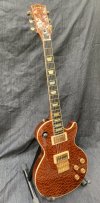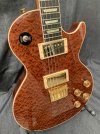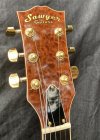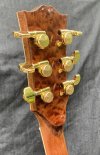Steve_Sawyer
Blues Newbie
Hey folks - I'd hoped to show this off with a recording for the Mike Bloomfield challenge, but couldn't get my solo up to scratch enough to participate in time.
Anyway, this is my latest build. I think I posted my first build (a Seafoam-green Telecaster copy) a couple of years ago. This one would have been in my hands sooner, but I had to take many months off to get a new queen-sized bed built right in the middle of this build, but I'd estimate the total time to get this one done at about 6 months. It was going to be much simpler (no binding on the headstock, no volute, no backstrap, no MOP inlays etc.) but as I went along, I kept saying, "Oh - I think I can do that".
Anyway, this turned out every bit as good as I'd hoped, and being my first humbucker-equipped guitar, it's been a blast to get some new tones out of my rig!
The body and neck are quarter-sawn ("ribbon-stripe") sapele, which is very similar to mahogany. The front of the body as well as the front and back of the headstock are veneered with "pommele" sapele. Fretboard is ebony, inlays are mother-of-pearl. Stewmac Golden Age "Parsons Street" humbuckers, EVO fret wire, Schaller roller-bridge, and cheap GFS locking tuners. The tuners work ok, but had some sharp edges that I had to sand off with some 2000 grit sandpaper, as they kept breaking strings!
The finish is Brite Tone waterborne instrument lacquer, 12 coats, applied with a brush (I don't have a spray rig or space to run one), then sanded and polished.




Anyway, this is my latest build. I think I posted my first build (a Seafoam-green Telecaster copy) a couple of years ago. This one would have been in my hands sooner, but I had to take many months off to get a new queen-sized bed built right in the middle of this build, but I'd estimate the total time to get this one done at about 6 months. It was going to be much simpler (no binding on the headstock, no volute, no backstrap, no MOP inlays etc.) but as I went along, I kept saying, "Oh - I think I can do that".
Anyway, this turned out every bit as good as I'd hoped, and being my first humbucker-equipped guitar, it's been a blast to get some new tones out of my rig!
The body and neck are quarter-sawn ("ribbon-stripe") sapele, which is very similar to mahogany. The front of the body as well as the front and back of the headstock are veneered with "pommele" sapele. Fretboard is ebony, inlays are mother-of-pearl. Stewmac Golden Age "Parsons Street" humbuckers, EVO fret wire, Schaller roller-bridge, and cheap GFS locking tuners. The tuners work ok, but had some sharp edges that I had to sand off with some 2000 grit sandpaper, as they kept breaking strings!
The finish is Brite Tone waterborne instrument lacquer, 12 coats, applied with a brush (I don't have a spray rig or space to run one), then sanded and polished.






